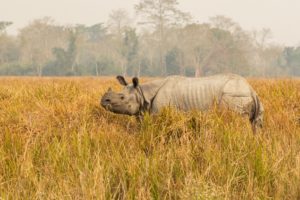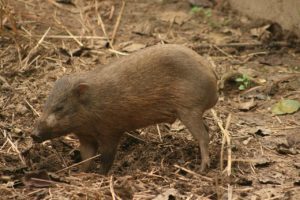Dr. Uttam Saikia
 Wildlife is a microcosm of the diversity of life on Earth. Although the term wildlife appears synonymous with vertebrates like birds and mammals that are hunted for sport, in essence the term represents all organisms that grow naturally in the wild without any human intervention. At the present juncture, diversity of life on Earth is at the lowest ebb in human history. Realising the grave harm inflicted on Mother Nature, Homo sapiens have woken up of late to the reality of a bleak future. Nations across the globe had undertaken corrective measures to halt biodiversity loss, some aimed at protecting the charismatic flagship species including India. Many times, it appears that in the face of a relentless onslaught of the all-pervasive human race, conservation of biodiversity or wildlife (in a restrictive sense) is a losing battle. But as we
Wildlife is a microcosm of the diversity of life on Earth. Although the term wildlife appears synonymous with vertebrates like birds and mammals that are hunted for sport, in essence the term represents all organisms that grow naturally in the wild without any human intervention. At the present juncture, diversity of life on Earth is at the lowest ebb in human history. Realising the grave harm inflicted on Mother Nature, Homo sapiens have woken up of late to the reality of a bleak future. Nations across the globe had undertaken corrective measures to halt biodiversity loss, some aimed at protecting the charismatic flagship species including India. Many times, it appears that in the face of a relentless onslaught of the all-pervasive human race, conservation of biodiversity or wildlife (in a restrictive sense) is a losing battle. But as we  will see below, there are silver linings too. As our country celebrates National Wildlife Week between October 1-8, with the primary goal of raising awareness on wildlife conservation and to ensure long term survival through critical actions, this is also a time to retrospect on the success and failures in our long history of wildlife conservation. Although the idea of protection of nature is ingrained in Indian culture since time immemorial, some of the most critical conservation actions had taken place in the last century or so. When the historic Indian Wildlife (Protection) Act was enacted in 1972, five National Parks and thirty-six Wildlife Sanctuaries were existent in the country. In the following account, a few of the most effective and spectacular success stories of wildlife conservation in India (but not restricted to) are highlighted including a few charismatic species that have tremendous symbolic value.
will see below, there are silver linings too. As our country celebrates National Wildlife Week between October 1-8, with the primary goal of raising awareness on wildlife conservation and to ensure long term survival through critical actions, this is also a time to retrospect on the success and failures in our long history of wildlife conservation. Although the idea of protection of nature is ingrained in Indian culture since time immemorial, some of the most critical conservation actions had taken place in the last century or so. When the historic Indian Wildlife (Protection) Act was enacted in 1972, five National Parks and thirty-six Wildlife Sanctuaries were existent in the country. In the following account, a few of the most effective and spectacular success stories of wildlife conservation in India (but not restricted to) are highlighted including a few charismatic species that have tremendous symbolic value.
 Bringing back Rhinos in Kaziranga National Park: The Greater one horned Rhino or Indian Rhino is one of the most iconic animals in India. Reminiscent of a prehistoric creature, the origin of Rhino can be traced back to 50 million years ago. The Indian Rhino is one of the five extant species of Rhino worldwide. A specialist of alluvial grassland, Indian Rhino was once widespread from Pakistan to the Indo-Myanmar border through the Indus, Ganges and Brahmaputra basin and also parts of Nepal, Bhutan and Bangladesh. However, as a result of habitat loss and climatic changes, the range of Indian Rhino drastically reduced by the 19th century and by the early 1990s, the estimated population declined to a lowly 100 individuals. An extensive patch of alluvial grassland in Central Assam called Kaziranga was known to harbour many of these Rhinos. In the year 1904, Baroness Mary Victoria Curzon, the wife of then Viceroy of India Lord Curzon visited Kaziranga. As destiny had it, she could not see a single Rhino except for the hoof marks indicating a low population density. Upon her return, she insisted her husband undertake protection measures for Rhino in Kaziranga and Lord Curzon obliged to her proddings. In June, 2005, Kaziranga was declared as a Proposed Reserved Forest with an area of 232 sq km. The rest is history! Upon declaration as Reserved Forest and subsequently elevated as Wildlife Sanctuary and National Park in 1974, hunting was strictly prohibited in the area. Due to the strict protection measures, the Rhino population gradually rebounded in Kaziranga. The first ever population estimates of Rhino in the Park in 1966 puts the population figure at 366-400 animals. Unfortunately, starting in the 1960s, a relatively new phenomenon of rhino poaching across its range also increased alarmingly, driven by increased demand for rhino horn in illegal international trade. Despite having considerable armed protection for the park, many Rhinos got killed every year especially during 1980-1993. However, protection measures have increased considerably since with high concentration of anti-poaching camps, possibly some of the highest in the world. Besides, habitat management practices coupled with sensitization of the peripheral areas also helped considerably. According to the latest 2022 census, Kaziranga harbours 2613 rhinos, about 70 percent of the global population! This has been a dramatic turnaround for Indian Rhino, within a span of about 120 years, the Park saw over 200-fold increase in Rhino population. Kaziranga stands as a model of effective species conservation for the world to emulate.
Bringing back Rhinos in Kaziranga National Park: The Greater one horned Rhino or Indian Rhino is one of the most iconic animals in India. Reminiscent of a prehistoric creature, the origin of Rhino can be traced back to 50 million years ago. The Indian Rhino is one of the five extant species of Rhino worldwide. A specialist of alluvial grassland, Indian Rhino was once widespread from Pakistan to the Indo-Myanmar border through the Indus, Ganges and Brahmaputra basin and also parts of Nepal, Bhutan and Bangladesh. However, as a result of habitat loss and climatic changes, the range of Indian Rhino drastically reduced by the 19th century and by the early 1990s, the estimated population declined to a lowly 100 individuals. An extensive patch of alluvial grassland in Central Assam called Kaziranga was known to harbour many of these Rhinos. In the year 1904, Baroness Mary Victoria Curzon, the wife of then Viceroy of India Lord Curzon visited Kaziranga. As destiny had it, she could not see a single Rhino except for the hoof marks indicating a low population density. Upon her return, she insisted her husband undertake protection measures for Rhino in Kaziranga and Lord Curzon obliged to her proddings. In June, 2005, Kaziranga was declared as a Proposed Reserved Forest with an area of 232 sq km. The rest is history! Upon declaration as Reserved Forest and subsequently elevated as Wildlife Sanctuary and National Park in 1974, hunting was strictly prohibited in the area. Due to the strict protection measures, the Rhino population gradually rebounded in Kaziranga. The first ever population estimates of Rhino in the Park in 1966 puts the population figure at 366-400 animals. Unfortunately, starting in the 1960s, a relatively new phenomenon of rhino poaching across its range also increased alarmingly, driven by increased demand for rhino horn in illegal international trade. Despite having considerable armed protection for the park, many Rhinos got killed every year especially during 1980-1993. However, protection measures have increased considerably since with high concentration of anti-poaching camps, possibly some of the highest in the world. Besides, habitat management practices coupled with sensitization of the peripheral areas also helped considerably. According to the latest 2022 census, Kaziranga harbours 2613 rhinos, about 70 percent of the global population! This has been a dramatic turnaround for Indian Rhino, within a span of about 120 years, the Park saw over 200-fold increase in Rhino population. Kaziranga stands as a model of effective species conservation for the world to emulate.
Saving the Pygmy hog: The smallest and rarest of all the living species of pigs in the world, Pygmy hog is an evolutionary unique and diminutive animal weighing less than 10 kg for an adult male. Another specialist of the tall grasslands on the foothills of Himalayas, it was once distributed in the Terai belt from Uttar Pradesh through Nepal, Sikkim, West Bengal, Assam and Bangladesh. However, due to large-scale destruction and encroachment of its habitat, the hog became rare and by 1960 was thought to be extinct. In 1971, J. Tessier-Yandell, a tea planter purchased several of these hogs from the tea garden market that had fled a grassland fire in the adjacent Bornadi Wildlife Sanctuary. He informed the UK based Durrell Wildlife Conservation Trust about the find and this event can be considered as rediscovery of this elusive hog. Scientists of Durrell Trust namely former chair of IUCN Pig Specialist Group Willliam Oliver began field surveys in 1977 and by early 1980s it was determined that a very small sub-population of pygmy hogs exist in Manas National Park and adjacent Bornadi Wildlife Sanctuary. However, continual human encroachment, poaching and civil unrest in the region had complicated any conservation effort to save this species. In 1995, a platform was formed with Durrell Wildlife Conservation Trust, the IUCN/SSC Wild Pig Specialist Group, the Assam Forest Department and Union Ministry of Environment and Forest, India for setting up a conservation programme for this species. In 1996, the Pygmy Hog Conservation Programme (PHCP) was launched with the aim of captive breeding and reintroduction of the species. Six individuals captured from Manas National Park were taken to the newly established Pygmy Hog Conservation Research and Breeding Centre near Guwahati to initiate the captive breeding programme which turned out to be highly successful. Following scientific management and breeding, the captive hog population increased to a dramatic 80 individuals in 2007. A pre-release facility near Nameri National Park was established where the captive born individuals were pre conditioned before releasing into the wild. The first reintroduction was conducted in 2008 in Sonai Rupai Wildlife Sanctuary in the Himalayan foothills. Till date, 170 individuals of captive bred pygmy hog were released in several protected areas of Assam and this number exceeds the currently surviving original wild population. By implementing a dedicated scientific conservation programme, conservationists were able to bring back a species from the brink of extinction.
Turnaround for Bengal Tiger: The most iconic of all Indian animals, Bengal Tiger is India’s national animal and part of our cultural and natural heritage since antiquity. It was estimated that about a lakh tigers roamed the Indian subcontinent at the turn of the 20th century. Unfortunately, this majestic animal fell victim to illegal poaching, loss of prey base and destruction and fragmentation of its habitat so much so that by the 1970s, only about 1800 individuals remained in the country. Alarmed by this dramatic decline and unabated threats to the surviving animals, the Government of India launched a conservation programme called Project Tiger in 1973. Noted biologist and forest officer Kailash Sankhala who was instrumental in highlighting the plight of Bengal Tigers was made the first Director of Project Tiger and Jim Corbett Tiger Reserve was the first Tiger Reserve created for the purpose. Tiger being an apex predator, Project Tiger holistically aimed to conserve the species through protection of the habitat and its prey species. These dedicated tiger conservation areas which are essentially a part of the existing network of Protected Areas in India have now been expanded to fifty-five reserves covering a total area of over seventy-eight thousand square kilometres. The success of Project Tiger has been phenomenal, according to the latest population estimation data released by the National Tiger Conservation Authority in 2023, there are 3167 individuals of Bengal Tiger in India. This is an enviable seventy percent of the total global population of tigers. Achieving this is no mean task in a populous country like India where conservation efforts are always on odds with developmental goals. No doubt, we need to sustain this momentum to ensure a bright future for this gentle beast.
(The author is a scientist working in the Zoological Survey of India, Shillong.)



